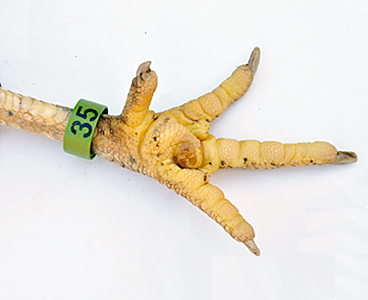
Bumblefoot describes a chicken’s inflamed foot with a hard, swollen abscess in the foot pad. The word bumble originally referred to the affected chicken’s unsteady gait caused by the swelling. In recent times, the core of the abscess, or the abscess itself, has been referred to as a bumble.
The abscess may start out as a callus that develops, and then splits, when a chicken spends too much time on a concrete or hardware cloth floor. It may also start as a bruise or cut occurring when a chicken scratches in hard or rocky soil or jumps down from a high perch onto a hard surface.
Staphylococcus aureus bacteria, present wherever there are chickens, enters the wound and causes infection, swelling, and lameness. Although this infection is not contagious, its frequent appearance in a flock indicates the need for management changes.
Signs of Bumblefoot
A chicken that is reluctant to walk, and limps when it does walk, is the usual first sign of bumblefoot. The chicken’s foot may look swollen and feel hot.
At the bottom of the foot will be a callus-like lump. If the infection is recent, the callus with be relatively soft. Cleaning the foot, packing the abscess with a suitable antibiotic, and moving the bird to a clean environment may be all that’s needed.
If the infection has been festering, the callus will be hard and covered with a black scab, in which case it won’t go away until the core is removed. Unless you can find a veterinarian willing to perform this surgery, you will have to do it yourself. Here’s how:
Soften the Abscess
Stand the chicken in warm water for about 10 minutes, gently massaging the foot to rinse off any clinging dirt. Epsom salt dissolved in the water will reduce inflammation and help soothe the foot.
Avoid letting the chicken drink the water its standing in. For one thing, the water will contain nasty bacteria from the infected foot. For another, Epsom salt is a laxative.
Remove the Core
After about 10 minutes of soaking the foot, the softened scab should pull off easily. Some of the abscess’s yellowish, cheesy, or waxy core may also come loose.
With the scab removed, encourage more of the core to come out by using your fingers to press outward, away from the abscess. Avoid causing further injury by squeezing into the abscess.
Sometimes tweezers may be used to pull out the abscess core. A large and hard abscess may need to be scraped or peeled out with a sharp knife, such as a utility knife, X-Acto knife, or surgeon’s scalpel.
As needed, repeat the soaking and core scraping. Work gently and take your time until the abscess has been thoroughly cleaned.
Rinse and Pack
Rinse the abscess with Betadine, saline wound wash, or sodium hypochlorite (Dakin’s Solution). After the abscess has been thoroughly cleaned out, pack it with an antibacterial, such as Neomycin, which comes in either powder form (trade name Neo-Predef) or as an ointment (trade name Neosporin, among others).
Wrap the Foot
Use a gauze pad, secured with first-aid tape or thin strips of vet wrap, to wrap the foot and keep it clean while it heals. Take care not to make the wrap too tight. Repeat this procedure every 2 or 3 days while the abscess has healed.
Meanwhile, house the recovering chicken in a warm, safe, clean environment with plenty of water and adequate nutrition. Temporarily remove perching sites that may tempt the bird to roost, possibly reinjuring the foot when it jumps back down.
Bumblefoot Prevention
Preventing bumblefoot includes these sound management practices:
- Make sure the lowest perch in the coop is no higher than 18 inches.
- Round off corners of perches and sand off splinters.
- Provide clean, soft, deep, dry bedding
- Feed a properly balanced ration.
- Not breeding susceptible chickens will avoid producing more of the same.
Cautionary Note
A human, especially a child or an elderly person, could potentially get a superficial skin infection (impetigo) while treating a chicken for bumblefoot. As a precaution, wear disposable gloves during treatment. Carefully dispose of material removed from the abscess, as well as the dressings, since they are loaded with bacteria. Discard or disinfect all instruments after every use. Thoroughly wash your hands afterward.
And that’s today’s news from the Cackle Coop.
Gail Damerow, author, The Chicken Health Handbook

